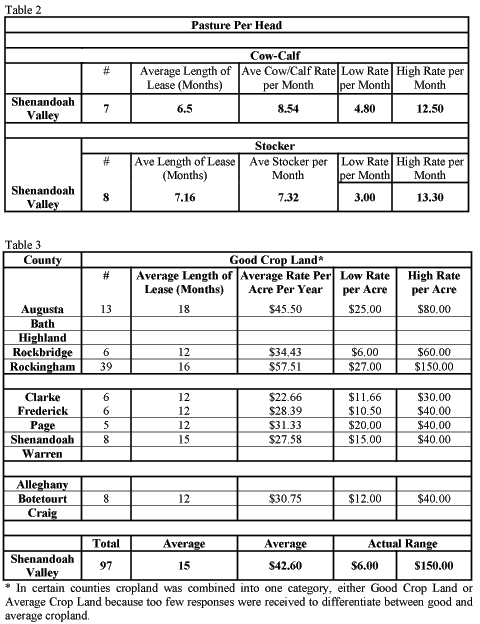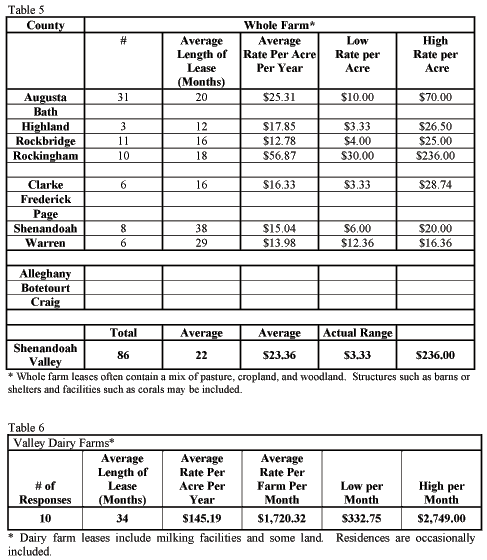
You've reached the Virginia Cooperative Extension Newsletter Archive. These files cover more than ten years of newsletters posted on our old website (through April/May 2009), and are provided for historical purposes only. As such, they may contain out-of-date references and broken links.
To see our latest newsletters and current information, visit our website at http://www.ext.vt.edu/news/.
Newsletter Archive index: http://sites.ext.vt.edu/newsletter-archive/

2005 Land Rental Guide for the Shenandoah Valley
Farm Business Management Update, August/September 2005
By Bill Whittle (wwhittle@vt.edu), Extension Agent, Farm Business Management, Page County, and Tom Stanley (stanleyt@vt.edu), Extension Agent, Farm Business Management, Northwest District

During late fall 2004, the Extension's Northwest District Farm Business Management staff surveyed Shenandoah Valley farmers in 14 counties on land rental values. A total of 291 landowners and tenants representing 524 separate lease agreements responded to the survey. Respondents were split almost evenly between landlords and tenants with 48% landowners and 52% tenants. Several respondents indicated that they were both a landlord and a tenant.
This information is used by landowners, tenants, and agricultural lenders as a starting point for determining fair market rental value for land. Terms of leases vary greatly from contract to contract. Of those answering the survey, 39% said that their lease agreement was a written document while 61% said that their lease was oral. In many situations, individuals had both oral and written lease agreements. Over the years, the percentage of written agreements has increased as both the tenant and landlord see the benefits of having the terms of the lease spelled out.
The tables summarize results of the 2005 survey. They provide the average rental rate and length of lease for use of land. However, averages tell only part of the story. It is valuable to know the range involved with lease rates and length of lease that has been negotiated. This data is also available from the tables.
Averages are reported by county and for the Shenandoah Valley. All averages are weighted averages, meaning that larger tracts of land rented at a given rate have more influence on the overall average rate than a small parcel of land. Rental rates are reported for the following categories: 1) Pasture per acre; 2) Pasture per head; 3) Good and Average Cropland (includes hay land) as determined by soil productivity groupings and farmer management in a typical year (Good Cropland = Class 1 & Class 2 and Average Cropland and Hay Land = Class 3 to 5); 4) Whole Farm; and 5) Dairy Farm.
The reliability of the average figures reported increases as the number of responses increase. No data were reported for a county unless at least three lease agreements were reported. However, these data were used to compile the Shenandoah Valley average. Within a rental category, the very high rental rates were generally for smaller parcels of land, and the very low rental rates often had other circumstances involved such as the desire by landowner to maintain Land Use Valuation on the parcel or a family relationship between landowner and tenant.
This year's survey requested information on barter leases. Forty-six (15.7% of all respondents) respondents noted that they were renting land based on barter arrangements. Barter situations are complex and difficult to compile as an average and range because each barter is different; however, some broad "similarities" were determined. Most barter rentals involved Hay and Pasture, and the vast majority dealt with less than 30 acres. In most situations, the tenant had to keep the land mowed and cleared of heavy brush. In several instances, year round caretaker responsibilities such as mowing the lawn and snow removal were involved. In several instances, the desire to keep the land in Land-Use and to keep it productive appeared to be the primary factors for the barter. Because of these variations, barter arrangements were not included in the county averages or ranges.






Visit Virginia Cooperative Extension